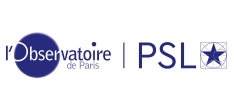Time-series analysis of broadband photometry of Neptune from K2
Résumé
We report here on our search for excess power in photometry of Neptune collected by the K2 mission that may be due to intrinsic global oscillations of the planet Neptune. To conduct this search, we developed new methods to correct for instrumental effects such as intrapixel variability and gain variations. We then extracted and analyzed the time-series photometry of Neptune from 49 days of nearly continuous broadband photometry of the planet. We find no evidence of global oscillations and place an upper limit of ∼5 ppm at 1000 $\mu$Hz for the detection of a coherent signal. With an observed cadence of 1 minute and a point-to-point scatter of less than 0.01%, the photometric signal is dominated by reflected light from the Sun, which is in turn modulated by atmospheric variability of Neptune at the 2% level. A change in flux is also observed due to the increasing distance between Neptune and the K2 spacecraft and the solar variability with convection-driven solar p modes present.
| Origine | Fichiers éditeurs autorisés sur une archive ouverte |
|---|

